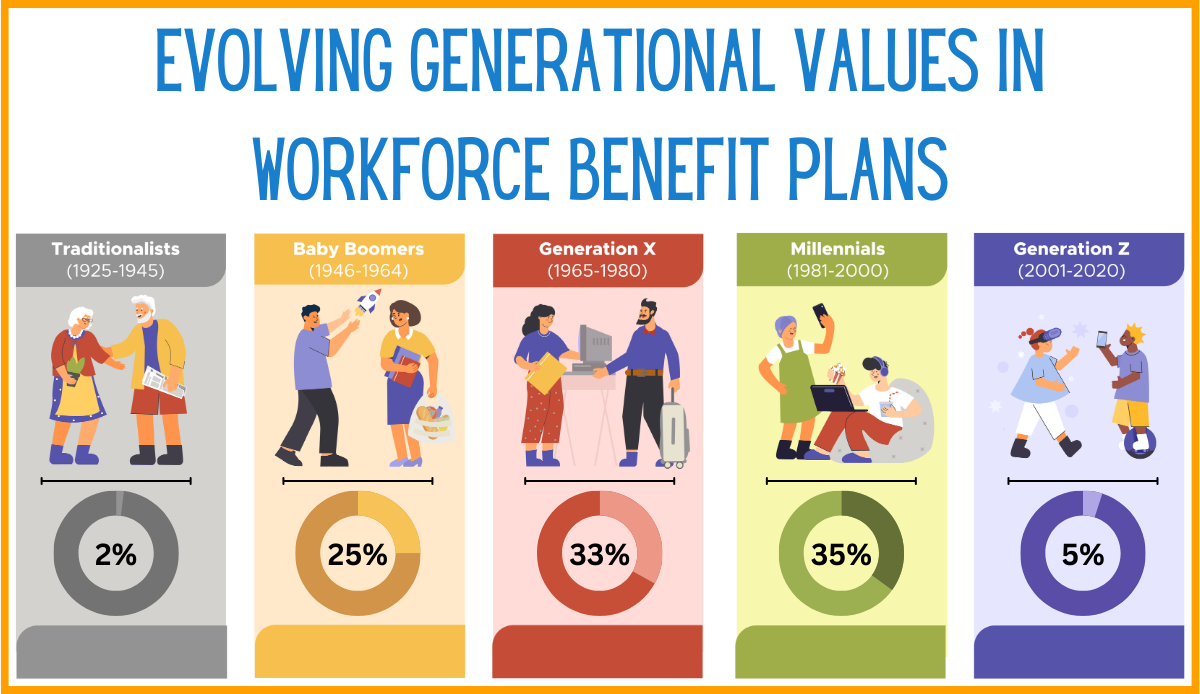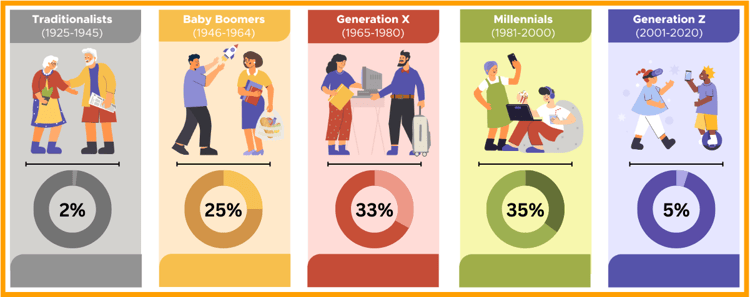6 min read
Evolving Generational Values in Workforce Benefit Plans
![]() Sarah Ensch
:
Sep 19, 2023 9:30:00 AM
Sarah Ensch
:
Sep 19, 2023 9:30:00 AM


With five unique generations represented, today’s workforce is more diverse than ever before. It can be challenging for employers to manage each group’s lifestyle preferences and provide them with ideal employment benefits. According to Purdue Global, “10,000 Baby Boomers reach retirement age every day, and Gex Xers will outnumber them by 2028.” With the decline of Baby Boomers in the workforce and the growth of the Millennial and Gen Z generations, employers and the human resource professionals who support them are learning to adapt to employees’ evolving relationships with organizations, authorities, and work styles. Additionally, healthcare values are continuously changing as more employees prioritize mobility, independence, and personal control. What was once valued by Baby Boomers and Gen X workers differs dramatically from the values of the Millennial and Gen Z generations. For this reason, offering multigenerational employees the same healthcare benefits will likely not result in the same effect on employee recruitment and retention efforts.
According to Pew Research, the five generations of today’s workforce are Traditionists or “The Silent Generation,” Baby Boomers, Generation X or “Gen Xers,” Millennials or “Generation Y,” and Generation Z or “Gen Zers.” Below, we will review the generational characteristics of today’s workforce and explain how HR professionals and employers can meet each generation’s expectations for healthcare options and additional benefits.
Generational Characteristics
Numerous common traits separate the distinct generations currently in the workforce, from different world views and preferred communication styles to motivation tactics and healthcare concerns. Significant historical events also shape the multigenerational workforce, influencing how different generations work, respond to change, and communicate. For example, the invention of the World Wide Web in 1989 resulted in Millennials being the first tech-savvy, digitally focused generation. Alternatively, there are shared priorities and values among respondents from all generations, according to a Forbes article. They found that every generation valued choice and control, recognition and appreciation, security and value, work-life balance, and a bright future.
Traditionalists (born 1925-1945) represent 2% of the workforce due to their advanced age. They value hard work, respect, and providing long-term value to their place of employment. Baby Boomers (born 1946-1964) comprise 25% of the workforce, following closely behind Traditionalists in dwindling representation due to retirement from the workforce. They value company loyalty, teamwork, and a structured schedule and environment. Generation X (born 1965-1980) makes up an estimated 33% of the workforce. Gen Xers value scheduling flexibility, personal independence, and work-life balance. Millennials (born 1981-2000) comprise 35% of the workforce; however, this number is expected to increase significantly as they complete formal education and begin to seek employment. They value responsibility and experience and are self-proclaimed “digital natives” like Gen Zers. Generation Z (born 2001-2020) comprises 5% of the workforce but is expected to reach 8.3% by 2030, according to SHRM. They value diversity, individuality, and creativity. Gen Zers have an elevated appreciation for technology and are the most digitally advanced generation yet. This cohort has also contributed to notable technological advances such as artificial intelligence (AI). Further, according to a Visier report, younger generations are nearly twice as likely to leave jobs in search of better opportunities.
Understanding each generation’s management style preferences can also help employers effectively communicate with each distinct group and know what employment healthcare benefits to offer. For example, Traditionalists and Baby Boomers share many similar traits in how they communicate and achieve career goals. Managers and HR professionals can honor these generations' values by providing contribution opportunities, specifying goals and deadlines, affording opportunities for mentor roles, and offering coaching-style feedback. In terms of healthcare benefits, these two generations generally prefer numerous options to choose from, clear and concise communication, and managerial support throughout the process. Gen X and Millennials value immediate feedback, flexible work arrangements, work-life balance, and career development opportunities. For these two groups, it is best to provide a menu of benefits, including mobile-friendly options that offer ease and convenience. As previously discussed, Gen Z highly values technology and personal independence. Additionally, Gen Z is motivated by individuality and personalization. For this reason, employers should offer a wide range of healthcare benefits and let them choose the plan that best suits their needs.
What healthcare benefits do different generations value?
Generally, employers and HR professionals seeking to hire top talent should understand each generation’s values and preferences regarding healthcare to promote employee loyalty and job satisfaction. According to SHRM, 60% of employees ranked benefits as a “very important” aspect of job satisfaction. However, each generation generally prioritizes different healthcare benefits at various stages of life.
Traditionalists
Although the Traditionalist generation only accounts for 2% of the workforce, they are the highest group of healthcare users, just ahead of Baby Boomers. They seek highly trusted doctors and traditional healthcare options. Traditionalists value familiarity and are likely to rely heavily on their primary care physician (PCP) for health advice. As a result of a lack of trust and experience with technology, this generation does not favor technological advancements fueled by younger generations, such as telemedicine, mobile accessibility to healthcare information, and AI.
Baby Boomers
Like Traditionalists, Baby Boomers prioritize high-quality care and well-vetted doctors as they age and care needs for existing and developing health conditions increase. Baby Boomers also often act as caregivers to parents or advisers to children, and they frequently make health decisions based on word-of-mouth recommendations and positive reputations. Additionally, Baby Boomers who are still in the workforce are nearing retirement age, so offering benefits that help them save funds for future use may be highly valued by this cohort.
Generation X
Generation X prioritizes convenience and quality of service. While they share some preferences with Traditionalists and Boomers, Gen Xers have more in common with Millennials regarding mobile accessibility and individual experience. Gen X seeks expert-driven advice from trusted healthcare professionals when making health decisions and can be easily influenced by advertisements on TV or other media. They are often heavy consumers of healthcare services and frequently visit health clinics for themselves or as caretakers for their dependent parents or children. For this reason, convenience, personal choice, and ease of use are often valued healthcare coverage attributes for Gen Xers.
Millennials
Millennials grew up with the internet at their fingertips. Most own multiple technology devices, including smartphones, and it is common for them to spend several hours a day online. As a result, these cohorts prefer instant digital options. Their fast-paced lifestyle has also resulted in significant advancements in the healthcare industry that benefit doctors and patients alike, such as online appointment scheduling and access to medical records. Currently, Millennials are the lowest consumers of traditional healthcare services. However, by 2025, they will comprise 75% of the global workforce, according to The United States Census Bureau. While their need for in-person services will likely increase as they age, their current overall state of good health leads Millennials to prioritize cost transparency, the ability to track information online, and their emotional experience in healthcare services. They prefer peer-driven over expert-driven advice, and just one negative experience can cause a Millennial or Gen Zer to switch healthcare providers.
Generation Z
Generation Z workers tend to be interested in digital healthcare options, preventative care, and holistic wellness. 45% of Gen Zers do not have a PCP and are more likely to seek healthcare treatment only when required for an acute injury or illness. They often forego doctor’s office visits due to cost, time constraints, and inconvenience. Millennials and Gen Zers value mobility and personal control more than older generations due to early exposure to technology and coming of age in a post-pandemic world where remote healthcare services are gaining popularity over traditional options.
Be Cautious of Discrimination
Employers should consider compliance requirements with the Equal Employment Opportunity Commission’s (EEOC) guidelines and avoid making program decisions that may be discriminatory or create unequal treatment based on sex, race, color, or other protected class designation. Reviewing any changes to benefits programs with a qualified employment law attorney prior to implementation aids in ensuring EEOC compliance.
Best Practices
Employees have diverse health concerns and require different solutions. Creating flexible healthcare options allows employers to offer diverse benefits to attract a broad spectrum of top talent from all working generations. Additionally, create a flexible plan that includes salary increases, health insurance, retirement savings (401K), and ancillary benefits that appeal to all ages, such as continuing education reimbursement or flexible paid time off.
In June 2019, the federal government published a final rule allowing businesses of any capacity that do not offer group coverage plans to support more flexible health reimbursement arrangements (HRAs) called individual coverage health reimbursement arrangements (ICHRAs). Unlike other HRA group plans (i.e., QSEHRAs), ICHRAs do not cap annual allowance amounts; a business can assign and modify specific coverage amounts based on an employee’s classification (i.e., full-time, or part-time), age, and family size. One caveat; ensure you avoid discrimination by offering consistent reimbursements across distinct employee classes. An additional note; businesses can provide group coverage plans and ICHRAs simultaneously, however, a single employee cannot be covered under both plan options.
Researching your competitor’s benefits can also aid in ensuring your organization remains competitive in attracting talent. It also reduces the chance an employee will leave your organization to work for a competitor, offering greater choice and overall value to them.
Different generations have distinct communication methods, world views, and lifestyle preferences. However, whether a Traditionalist, Boomer, or Gen-Zer, every generation wants to feel valued by their employer and confident in their choice of employment. When choosing benefits programs to serve employees of all generations and stages of life, consider providing a range of options that appeal to a wide range of individual needs and priorities whenever feasible. This will not only encourage staff longevity but will also aid in ensuring EEOC compliance.
AccuSourceHR™ Workforce Solutions offers a wide range of services to make hiring easier for businesses and their human resource teams. Connect with us at marketing@accusourcehr.com for a complimentary program evaluation.
